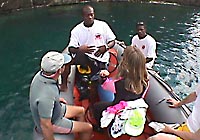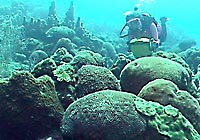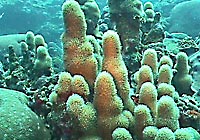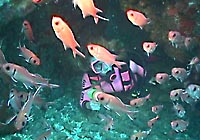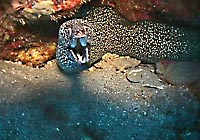 |
|||||||||||||||||||||||||
The volcano formed St. Vincent and made a place for coral reefs to grow. The rainforests prevent the land from eroding, which protects the coral reefs from soil that could wash into the ocean. Today we are exploring the coral reefs here in St. Vincent. We are diving with Kenard Cruickshank (CROOK-shank), owner of Wallilabou (WALLY-la-boo) Dive Experience, on St. Vincent's Caribbean (west) coast. Kenard speeds us out in his fast, inflatable boat to a dive site he calls Coral Castle. We put on our scuba equipment, grab our underwater scooters and zoom down below the boat. At about 35 feet underwater we see that this place gets its name from all the large corals rising up off the bottom like the towers on a castle. We discover that the volcanic rocks are completely covered with all sorts of corals. Just like yesterday when we saw plants growing on top of plants in the rainforest, here we see corals growing on top of corals! At this place we see a greater variety of corals growing all over here than we've seen at any other place we have explored. We see both hard corals and soft flexible corals, like sea fans. The most unusual hard corals we see are fuzzy pillar corals. Corals are made from tiny coral polyp animals. They usually feed at night, but pillar coral polyps feed both day and night. The fuzzy parts of these corals are the tiny coral polyps with their sea anemone-like tentacles reaching out to capture plankton floating in the sea. Next we go to a dive spot called The Rock Pile. We zoom over this reef, about 35 feet underwater, and see that this is a pile of volcanic rocks about the size of loaves of bread that look like they were all glued together. Corals and sponges grow on these rocks but do not cover them completely like they do at Coral Castle. What is neat about this spot are the tunnels that cut through the reef. We use our dive lights in the tunnels and find fish hiding in the dark, waiting for night to come. At night these fish will swim out over the reef to feed. As we swim through one tunnel we see something moving just over our heads, and it's not a fish! We turn over on our backs and shine our lights to the ceiling of the tunnel. It's a lobster! Lobsters are also night feeders. Lobsters hide during the day so big fish can't see them. At night, while the big fish are sleeping, the lobsters crawl across the reef to feed. We swim out of the tunnels and see something slithering across the reef. It's a spotted moray eel. As we follow the eel we see there are more eels along the bottom of the reef or poking their head out of holes in the coral. We discover this reef has more moray eels than anyplace we have ever explored in the world! It seems like there is a moray eel about every six feet! We are not scared because we know the moray eels will not try to attack us or hurt us. They are just looking for fish to eat. We are surprised though because moray eels usually hide in the day and swim around at night. Join us tomorrow as we return to St. Lucia to climb the Pitons and study the coral reefs. |
Karen listens as Kenard Cruickshank, of Wallilabou Dive Experience, tells us about what we should expect to see underwater during our dive.
On her underwater scooter, Karen cruises over a variety of different kinds of coral at "Coral Castle." Can you find the pillar coral and the brain coral? Notice one coral is starting to grow over the top of the brain coral.
This is pillar coral. See how this coral looks fuzzy? These are the coral polyp animals feeding. Most hard corals feed at night. Pillar corals feed day and night.
Karen swims through a tunnel at "The Rock Pile." All the red fish are blackbar soldierfish. These fish hide in tunnels and caves during the day, then come out at night to feed.
Inside a tunnel we find a spotted lobster. This lobster is about 10 inches long. Lobsters hide in tunnels and caves during the day, then come out a night to feed.
Do you think this moray eel is getting ready to bite us? To find out, read our journal from 2/22. This moray is resting under a ledge. It is about 3 feet long. This is just one of over a dozen moray eels we saw on our scuba dive. |
||||||||||||||||||||||||
home | basecamp | archives | other expeditions | kids' page | contact us © 2001, The Ocean Adventure All rights reserved. |
